Flat Earth

Flat Earth is an archaic and scientifically disproven conception of the Earth's shape as a plane or disk. Many ancient cultures subscribed to a flat-Earth cosmography, notably including ancient near eastern cosmology. The model has undergone a recent resurgence as a conspiracy theory.[1]
The idea of a spherical Earth appeared in ancient Greek philosophy with Pythagoras (6th century BC). However, most pre-Socratics (6th–5th century BC) retained the flat-Earth model. In the early 4th century BC, Plato wrote about a spherical Earth. By about 330 BC, his former student Aristotle had provided strong empirical evidence for a spherical Earth. Knowledge of the Earth's global shape gradually began to spread beyond the Hellenistic world.[2][3][4][5] By the early period of the Christian Church, the spherical view was widely held, with some notable exceptions. In contrast, ancient Chinese scholars consistently describe the Earth as flat, and this perception remained unchanged until their encounters with Jesuit missionaries in the 17th century.[6] Traditionalist Muslim scholars have maintained that the earth is flat, though, since the 9th century, Muslim scholars tended to believe in a spherical Earth.[7][8] Despite the scientific facts and obvious effects of Earth's sphericity, pseudoscientific[9] flat-Earth conspiracy theories persist, and from the 2010s at latest, believers in a flat earth have increased, both as membership in modern flat Earth societies, and as unaffiliated individuals using social media.[10][11] In a 2018 study reported on by Scientific American, only 82% of 18 to 24 year old American respondents agreed with the statement "I have always believed the world is round". However, a firm belief in a flat Earth is rare, with less than 2% acceptance in all age groups.[12]
It is a historical myth that medieval Europeans generally thought the Earth was flat.[13] This myth was created in the 17th century by Protestants to argue against Catholic teachings.[14]
History
Belief in flat Earth
Near East
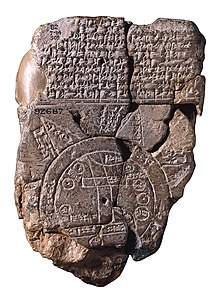
In early Egyptian[15] and Mesopotamian thought, the world was portrayed as a disk floating in the ocean. A similar model is found in the Homeric account from the 8th century BC in which "Okeanos, the personified body of water surrounding the circular surface of the Earth, is the begetter of all life and possibly of all gods."[16]
The Pyramid Texts and Coffin Texts of ancient Egypt show a similar cosmography; Nun (the Ocean) encircled nbwt ("dry lands" or "Islands").[17][18][19][full citation needed]
The Israelites also imagined the Earth to be a disc floating on water with an arched firmament above it that separated the Earth from the heavens.[20] The sky was a solid dome with the Sun, Moon, planets, and stars embedded in it.[21]
Greece
Poets
Both Homer[22] and Hesiod[23] described a disc cosmography on the Shield of Achilles.[24][25] This poetic tradition of an Earth-encircling (gaiaokhos) sea (Oceanus) and a disc also appears in Stasinus of Cyprus,[26] Mimnermus,[27] Aeschylus,[28] and Apollonius Rhodius.[29]
Homer's description of the disc cosmography on the shield of Achilles with the encircling ocean is repeated far later in Quintus Smyrnaeus' Posthomerica (4th century AD), which continues the narration of the Trojan War.[30]
Philosophers
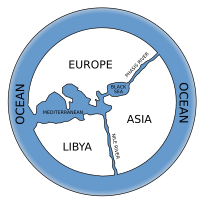
Several pre-Socratic philosophers believed that the world was flat: Thales (c. 550 BC) according to several sources,[32] and Leucippus (c. 440 BC) and Democritus (c. 460–370 BC) according to Aristotle.[33][34][35]
Thales thought that the Earth floated in water like a log.[36] It has been argued, however, that Thales actually believed in a spherical Earth.[37][38] Anaximander (c. 550 BC) believed that the Earth was a short cylinder with a flat, circular top that remained stable because it was the same distance from all things.[39][40] Anaximenes of Miletus believed that "the Earth is flat and rides on air; in the same way the Sun and the Moon and the other heavenly bodies, which are all fiery, ride the air because of their flatness".[41] Xenophanes (c. 500 BC) thought that the Earth was flat, with its upper side touching the air, and the lower side extending without limit.[42]
Belief in a flat Earth continued into the 5th century BC. Anaxagoras (c. 450 BC) agreed that the Earth was flat,[43] and his pupil Archelaus believed that the flat Earth was depressed in the middle like a saucer, to allow for the fact that the Sun does not rise and set at the same time for everyone.[44]
Historians
Hecataeus of Miletus believed that the Earth was flat and surrounded by water.[45] Herodotus in his Histories ridiculed the belief that water encircled the world,[46] yet most classicists agree that he still believed Earth was flat because of his descriptions of literal "ends" or "edges" of the Earth.[47]
Northern Europe
The ancient Norse and Germanic peoples believed in a flat-Earth cosmography with the Earth surrounded by an ocean, with the axis mundi, a world tree (Yggdrasil), or pillar (Irminsul) in the centre.[48][49] In the world-encircling ocean sat a snake called Jormungandr.[50] The Norse creation account preserved in Gylfaginning (VIII) states that during the creation of the Earth, an impassable sea was placed around it:[51]
And Jafnhárr said: "Of the blood, which ran and welled forth freely out of his wounds, they made the sea, when they had formed and made firm the Earth together, and laid the sea in a ring round. about her; and it may well seem a hard thing to most men to cross over it."
The late Norse Konungs skuggsjá, on the other hand, explains Earth's shape as a sphere:[52]
If you take a lighted candle and set it in a room, you may expect it to light up the entire interior, unless something should hinder, though the room be quite large. But if you take an apple and hang it close to the flame, so near that it is heated, the apple will darken nearly half the room or even more. However, if you hang the apple near the wall, it will not get hot; the candle will light up the whole house; and the shadow on the wall where the apple hangs will be scarcely half as large as the apple itself. From this you may infer that the Earth-circle is round like a ball and not equally near the sun at every point. But where the curved surface lies nearest the sun's path, there will the greatest heat be; and some of the lands that lie continuously under the unbroken rays cannot be inhabited.
East Asia
In ancient China, the prevailing belief was that the Earth was flat and square, while the heavens were round,[53] an assumption virtually unquestioned until the introduction of European astronomy in the 17th century.[54][55][56] The English sinologist Cullen emphasizes the point that there was no concept of a round Earth in ancient Chinese astronomy:[6]
Chinese thought on the form of the Earth remained almost unchanged from early times until the first contacts with modern science through the medium of Jesuit missionaries in the seventeenth century. While the heavens were variously described as being like an umbrella covering the Earth (the Kai Tian theory), or like a sphere surrounding it (the Hun Tian theory), or as being without substance while the heavenly bodies float freely (the Hsüan yeh theory), the Earth was at all times flat, although perhaps bulging up slightly.
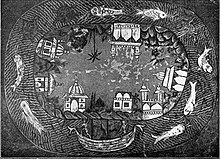
The model of an egg was often used by Chinese astronomers such as Zhang Heng (78–139 AD) to describe the heavens as spherical:[57]
The heavens are like a hen's egg and as round as a crossbow bullet; the Earth is like the yolk of the egg, and lies in the centre.
This analogy with a curved egg led some modern historians, notably Joseph Needham, to conjecture that Chinese astronomers were, after all, aware of the Earth's sphericity. The egg reference, however, was rather meant to clarify the relative position of the flat Earth to the heavens:[55]
In a passage of Zhang Heng's cosmogony not translated by Needham, Zhang himself says: "Heaven takes its body from the Yang, so it is round and in motion. Earth takes its body from the Yin, so it is flat and quiescent". The point of the egg analogy is simply to stress that the Earth is completely enclosed by Heaven, rather than merely covered from above as the Kai Tian describes. Chinese astronomers, many of them brilliant men by any standards, continued to think in flat-Earth terms until the seventeenth century; this surprising fact might be the starting-point for a re-examination of the apparent facility with which the idea of a spherical Earth found acceptance in fifth-century BC Greece.
Further examples cited by Needham supposed to demonstrate dissenting voices from the ancient Chinese consensus actually refer without exception to the Earth being square, not to it being flat.[6] Accordingly, the 13th-century scholar Li Ye, who argued that the movements of the round heaven would be hindered by a square Earth,[53] did not advocate a spherical Earth, but rather that its edge should be rounded off so as to be circular.[6] However, Needham disagrees, affirming that Li Ye believed the Earth to be spherical, similar in shape to the heavens but much smaller.[58] This was preconceived by the 4th-century scholar Yu Xi, who argued for the infinity of outer space surrounding the Earth and that the latter could be either square or round, in accordance to the shape of the heavens.[59] When Chinese geographers of the 17th century, influenced by European cartography and astronomy, showed the Earth as a sphere that could be circumnavigated by sailing around the globe, they did so with formulaic terminology previously used by Zhang Heng to describe the spherical shape of the Sun and Moon (i.e. that they were as round as a crossbow bullet).[60]
As noted in the book Huainanzi,[61] in the 2nd century BC, Chinese astronomers effectively inverted Eratosthenes' calculation of the curvature of the Earth to calculate the height of the Sun above the Earth. By assuming the Earth was flat, they arrived at a distance of 100000 li (approximately 200000 km). The Zhoubi Suanjing also discusses how to determine the distance of the Sun by measuring the length of noontime shadows at different latitudes, a method similar to Eratosthenes' measurement of the circumference of the Earth, but the Zhoubi Suanjing assumes that the Earth is flat.[62]
Alternate or mixed theories
Greece: spherical Earth

Pythagoras in the 6th century BC and Parmenides in the 5th century BC stated that the Earth is spherical,[63] and this view spread rapidly in the Greek world. Around 330 BC, Aristotle maintained on the basis of physical theory and observational evidence that the Earth was spherical, and reported an estimate of its circumference.[64] The Earth's circumference was first determined around 240 BC by Eratosthenes.[65] By the 2nd century AD, Ptolemy had derived his maps from a globe and developed the system of latitude, longitude, and climes. His Almagest was written in Greek and only translated into Latin in the 11th century from Arabic translations.
Lucretius (1st century BC) opposed the concept of a spherical Earth, because he considered that an infinite universe had no center towards which heavy bodies would tend. Thus, he thought the idea of animals walking around topsy-turvy under the Earth was absurd.[66][67] By the 1st century AD, Pliny the Elder was in a position to say that everyone agreed on the spherical shape of Earth,[68] though disputes continued regarding the nature of the antipodes, and how it is possible to keep the ocean in a curved shape.
South Asia

The Vedic texts depict the cosmos in many ways.[69][70] One of the earliest Indian cosmological texts pictures the Earth as one of a stack of flat disks.[71]
In the Vedic texts, Dyaus (heaven) and Prithvi (Earth) are compared to wheels on an axle, yielding a flat model. They are also described as bowls or leather bags, yielding a concave model.[72] According to Macdonell: "the conception of the Earth being a disc surrounded by an ocean does not appear in the Samhitas. But it was naturally regarded as circular, being compared with a wheel (10.89) and expressly called circular (parimandala) in the Shatapatha Brahmana."[73]
By about the 5th century AD, the siddhanta astronomy texts of South Asia, particularly of Aryabhata, assume a spherical Earth as they develop mathematical methods for quantitative astronomy for calendar and time keeping.[74]
The medieval Indian texts called the Puranas describe the Earth as a flat-bottomed, circular disk with concentric oceans and continents.[72][75] This general scheme is present not only in the Hindu cosmologies, but also in Buddhist and Jain cosmologies of South Asia.[72] However, some Puranas include other models. The fifth canto of the Bhagavata Purana, for example, includes sections that describe the Earth both as flat and spherical.[76][77]
Early Christian Church
During the early period of the Christian Church, the spherical view continued to be widely held, with some notable exceptions.[78] Athenagoras, an eastern Christian writing around the year 175 AD, said that the Earth was spherical.[79] Methodius (c. 290 AD), an eastern Christian writing against "the theory of the Chaldeans and the Egyptians" said: "Let us first lay bare ... the theory of the Chaldeans and the Egyptians. They say that the circumference of the universe is likened to the turnings of a well-rounded globe, the Earth being a central point. They say that since its outline is spherical, ... the Earth should be the center of the universe, around which the heaven is whirling."[79] Lactantius, a western Christian writer and advisor to the first Christian Roman Emperor, Constantine, writing sometime between 304 and 313 AD, ridiculed the notion of antipodes and the philosophers who fancied that "the universe is round like a ball. They also thought that heaven revolves in accordance with the motion of the heavenly bodies. ... For that reason, they constructed brass globes, as though after the figure of the universe."[80][79] Arnobius, another eastern Christian writing sometime around 305 AD, described the round Earth: "In the first place, indeed, the world itself is neither right nor left. It has neither upper nor lower regions, nor front nor back. For whatever is round and bounded on every side by the circumference of a solid sphere, has no beginning or end ..."[79]
The influential theologian and philosopher Saint Augustine, one of the four Great Church Fathers of the Western Church, similarly objected to the "fable" of antipodes:[81]
But as to the fable that there are Antipodes, that is to say, men on the opposite side of the Earth, where the sun rises when it sets to us, men who walk with their feet opposite ours that is on no ground credible. And, indeed, it is not affirmed that this has been learned by historical knowledge, but by scientific conjecture, on the ground that the Earth is suspended within the concavity of the sky, and that it has as much room on the one side of it as on the other: hence they say that the part that is beneath must also be inhabited. But they do not remark that, although it be supposed or scientifically demonstrated that the world is of a round and spherical form, yet it does not follow that the other side of the Earth is bare of water; nor even, though it be bare, does it immediately follow that it is peopled. For Scripture, which proves the truth of its historical statements by the accomplishment of its prophecies, gives no false information; and it is too absurd to say, that some men might have taken ship and traversed the whole wide ocean, and crossed from this side of the world to the other, and that thus even the inhabitants of that distant region are descended from that one first man.
Some historians do not view Augustine's scriptural commentaries as endorsing any particular cosmological model, endorsing instead the view that Augustine shared the common view of his contemporaries that the Earth is spherical, in line with his endorsement of science in De Genesi ad litteram.[82][83] C. P. E. Nothaft, responding to writers like Leo Ferrari who described Augustine as endorsing a flat Earth, says that "...other recent writers on the subject treat Augustine’s acceptance of the earth’s spherical shape as a well-established fact".[84][85]
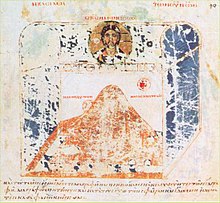
Diodorus of Tarsus, a leading figure in the School of Antioch and mentor of John Chrysostom, may have argued for a flat Earth; however, Diodorus' opinion on the matter is known only from a later criticism.[86] Chrysostom, one of the four Great Church Fathers of the Eastern Church and Archbishop of Constantinople, explicitly espoused the idea, based on scripture, that the Earth floats miraculously on the water beneath the firmament.[87]
Christian Topography (547) by the Alexandrian monk Cosmas Indicopleustes, who had traveled as far as Sri Lanka and the source of the Blue Nile, is now widely considered the most valuable geographical document of the early medieval age, although it received relatively little attention from contemporaries. In it, the author repeatedly expounds the doctrine that the universe consists of only two places, the Earth below the firmament and heaven above it. Carefully drawing on arguments from scripture, he describes the Earth as a rectangle, 400 days' journey long by 200 wide, surrounded by four oceans and enclosed by four massive walls which support the firmament. The spherical Earth theory is contemptuously dismissed as "pagan".[88][89][90]
Severian, Bishop of Gabala (d. 408), wrote that the Earth is flat and the Sun does not pass under it in the night, but "travels through the northern parts as if hidden by a wall".[91] Basil of Caesarea (329–379) argued that the matter was theologically irrelevant.[92]
Europe: Early Middle Ages
Early medieval Christian writers felt little urge to assume flatness of the Earth, though they had fuzzy impressions of the writings of Ptolemy and Aristotle, relying more on Pliny.[13]

With the end of the Western Roman Empire, Western Europe entered the Middle Ages with great difficulties that affected the continent's intellectual production. Most scientific treatises of classical antiquity (in Greek) were unavailable, leaving only simplified summaries and compilations. In contrast, the Eastern Roman Empire did not fall, and it preserved the learning.[93] Still, many textbooks of the Early Middle Ages supported the sphericity of the Earth in the western part of Europe.[94]
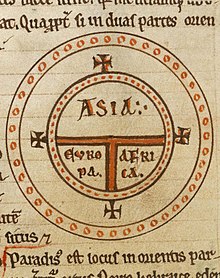
Europe's view of the shape of the Earth in Late Antiquity and the Early Middle Ages may be best expressed by the writings of early Christian scholars:
Bishop Isidore of Seville (560–636) taught in his widely read encyclopedia, the Etymologies, diverse views such as that the Earth "resembles a wheel"[95] resembling Anaximander in language and the map that he provided. This was widely interpreted as referring to a disc-shaped Earth.[96][97] An illustration from Isidore's De Natura Rerum shows the five zones of the Earth as adjacent circles. Some have concluded that he thought the Arctic and Antarctic zones were adjacent to each other.[98] He did not admit the possibility of antipodes, which he took to mean people dwelling on the opposite side of the Earth, considering them legendary[99] and noting that there was no evidence for their existence.[100] Isidore's T and O map, which was seen as representing a small part of a spherical Earth, continued to be used by authors through the Middle Ages, e.g. the 9th-century bishop Rabanus Maurus, who compared the habitable part of the northern hemisphere (Aristotle's northern temperate clime) with a wheel. At the same time, Isidore's works also gave the views of sphericity, for example, in chapter 28 of De Natura Rerum, Isidore claims that the Sun orbits the Earth and illuminates the other side when it is night on this side. See French translation of De Natura Rerum.[101] In his other work Etymologies, there are also affirmations that the sphere of the sky has Earth in its center and the sky being equally distant on all sides.[102][103] Other researchers have argued these points as well.[13][104][105] "The work remained unsurpassed until the thirteenth century and was regarded as the summit of all knowledge. It became an essential part of European medieval culture. Soon after the invention of typography it appeared many times in print."[106] However, "The Scholastics – later medieval philosophers, theologians, and scientists – were helped by the Arabic translators and commentaries, but they hardly needed to struggle against a flat-Earth legacy from the early middle ages (500–1050). Early medieval writers often had fuzzy and imprecise impressions of both Ptolemy and Aristotle and relied more on Pliny, but they felt (with one exception), little urge to assume flatness."[13]
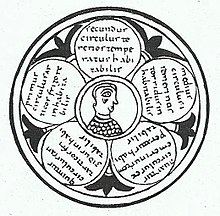
St Vergilius of Salzburg (c. 700–784), in the middle of the 8th century, discussed or taught some geographical or cosmographical ideas that St Boniface found sufficiently objectionable that he complained about them to Pope Zachary. The only surviving record of the incident is contained in Zachary's reply, dated 748, where he wrote:[107]
As for the perverse and sinful doctrine which he (Virgil) against God and his own soul has uttered – if it shall be clearly established that he professes belief in another world and other men existing beneath the Earth, or in (another) sun and moon there, thou art to hold a council, deprive him of his sacerdotal rank, and expel him from the Church.
Some authorities have suggested that the sphericity of the Earth was among the aspects of Vergilius's teachings that Boniface and Zachary considered objectionable.[108][109] Others have considered this unlikely, and take the wording of Zachary's response to indicate at most an objection to belief in the existence of humans living in the antipodes.[110][111][112][113][114] In any case, there is no record of any further action having been taken against Vergilius. He was later appointed bishop of Salzburg and was canonised in the 13th century.[115]

A possible non-literary but graphic indication that people in the Middle Ages believed that the Earth (or perhaps the world) was a sphere is the use of the orb (globus cruciger) in the regalia of many kingdoms and of the Holy Roman Empire. It is attested from the time of the Christian late-Roman emperor Theodosius II (423) throughout the Middle Ages; the Reichsapfel was used in 1191 at the coronation of emperor Henry VI. However the word orbis means "circle", and there is no record of a globe as a representation of the Earth since ancient times in the west until that of Martin Behaim in 1492. Additionally it could well be a representation of the entire "world" or cosmos.[116]
A recent study of medieval concepts of the sphericity of the Earth noted that "since the eighth century, no cosmographer worthy of note has called into question the sphericity of the Earth".[117] However, the work of these intellectuals may not have had significant influence on public opinion, and it is difficult to tell what the wider population may have thought of the shape of the Earth if they considered the question at all.
Europe: High and Late Middle Ages
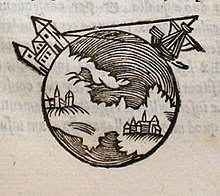
Hermann of Reichenau (1013–1054) was among the earliest Christian scholars to estimate the circumference of Earth with Eratosthenes' method. Thomas Aquinas (1225–1274), the most widely taught theologian of the Middle Ages, believed in a spherical Earth and took for granted that his readers also knew the Earth is round.[118][78] Lectures in the medieval universities commonly advanced evidence in favor of the idea that the Earth was a sphere.[119]

Jill Tattersall shows that in many vernacular works in 12th- and 13th-century French texts the Earth was considered "round like a table" rather than "round like an apple". She writes, "[I]n virtually all the examples quoted ... from epics and from non-'historical' romances (that is, works of a less learned character) the actual form of words used suggests strongly a circle rather than a sphere", though she notes that even in these works the language is ambiguous.[120]
Portuguese navigation down and around the coast of Africa in the latter half of the 1400s gave wide-scale observational evidence for Earth's sphericity. In these explorations, the Sun's position moved more northward the further south the explorers travelled. Its position directly overhead at noon gave evidence for crossing the equator. These apparent solar motions in detail were more consistent with north–south curvature and a distant Sun, than with any flat-Earth explanation. The ultimate demonstration came when Ferdinand Magellan's expedition completed the first global circumnavigation in 1521. Antonio Pigafetta, one of the few survivors of the voyage, recorded the loss of a day in the course of the voyage, giving evidence for east–west curvature.
Middle East: Islamic scholars
Prior to the introduction of Greek cosmology into the Islamic world, Muslims tended to view the Earth as flat, and Muslim traditionalists who rejected Greek philosophy continued to hold to this view later on while various theologians held opposing opinions.[121][8] Beginning in the 10th century onwards, some Muslim traditionalists began to adopt the notion of a spherical Earth with the influence of Greek and Ptolemaic cosmology.[122]
The Abbasid Caliphate saw a great flowering of astronomy and mathematics in the 9th century AD. Muslim scholars tended to believe in a spherical Earth from this period.[7]
In Quranic cosmology, the Earth (al-arḍ) was "spread out."[123] Whether or not this implies a flat earth was debated by Muslims.[8] Some modern historians believe the Quran saw the world as flat.[124][125] On the other hand, the 12th-century commentary, the Tafsir al-Kabir (al-Razi) by Fakhr al-Din al-Razi argues that though this verse does describe a flat surface, it is limited in its application to local regions of the Earth which are roughly flat as opposed to the Earth as a whole. Others who would support a ball-shaped Earth included Ibn Hazm.[8]
Ming Dynasty in China
A spherical terrestrial globe was introduced to Yuan-era Khanbaliq (i.e. Beijing) in 1267 by the Persian astronomer Jamal ad-Din, but it is not known to have made an impact on the traditional Chinese conception of the shape of the Earth.[126] As late as 1595, an early Jesuit missionary to China, Matteo Ricci, recorded that the Ming-dynasty Chinese say: "The Earth is flat and square, and the sky is a round canopy; they did not succeed in conceiving the possibility of the antipodes."[6]
In the 17th century, the idea of a spherical Earth spread in China due to the influence of the Jesuits, who held high positions as astronomers at the imperial court.[127] Matteo Ricci, in collaboration with Chinese cartographers and translator Li Zhizao, published the Kunyu Wanguo Quantu in 1602, the first Chinese world map based on European discoveries.[128] The astronomical and geographical treatise Gezhicao (格致草) written in 1648 by Xiong Mingyu (熊明遇) explained that the Earth was spherical, not flat or square, and could be circumnavigated.[127]
Myth of flat-Earth prevalence
In the 19th century, a historical myth arose which held that the predominant cosmological doctrine during the Middle Ages was that the Earth was flat. An early proponent of this myth was the American writer Washington Irving, who maintained that Christopher Columbus had to overcome the opposition of churchmen to gain sponsorship for his voyage of exploration. Later significant advocates of this view were John William Draper and Andrew Dickson White, who used it as a major element in their advocacy of the thesis[129] that there was a long-lasting and essential conflict between science and religion.[130] Some studies of the historical connections between science and religion have demonstrated that theories of their mutual antagonism ignore examples of their mutual support.[131][132]
Subsequent studies of medieval science have shown that most scholars in the Middle Ages, including those read by Christopher Columbus, maintained that the Earth was spherical.[133]
Modern flat Earth beliefs
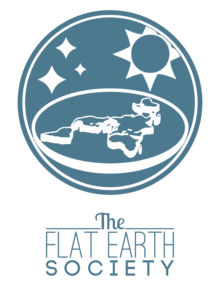
In the modern era, the pseudoscientific belief in a flat Earth originated with the English writer Samuel Rowbotham with the 1849 pamphlet Zetetic Astronomy. Lady Elizabeth Blount established the Universal Zetetic Society in 1893, which published journals. In 1956, Samuel Shenton set up the International Flat Earth Research Society, better known as the "Flat Earth Society" from Dover, England, as a direct descendant of the Universal Zetetic Society.
In the Internet era, the availability of communications technology and social media like YouTube, Facebook[134] and Twitter have made it easy for individuals, famous[135] or not, to spread disinformation and attract others to erroneous ideas, including that of the flat Earth.[10][11][136]
Modern believers in a flat Earth face overwhelming publicly accessible evidence of Earth's sphericity. They also need to explain why governments, media outlets, schools, scientists, surveyors, airlines and other organizations accept that the world is spherical. To satisfy these tensions and maintain their beliefs, they generally embrace some form of conspiracy theory. In addition, believers tend to not trust observations they have not made themselves, and often distrust, disagree with or accuse each other of being in league with conspiracies.[137]
Education
Before learning from their social environment, a child's perception of their physical environment often leads to a false concept about the shape of Earth and what happens beyond the horizon. Many children think that Earth ends there and that one can fall off the edge. Education helps them gradually change their belief into a realist one of a spherical Earth.[138]
See also
References
- ^ Dunning, Brian. "The Flat Earth Theory". Skeptoid. Retrieved June 17, 2023.
- ^ "Romanische Literaturen I". Institut für Literaturwissenschaft (in German). Universität Stuttgart. n.d. Retrieved April 4, 2022.
- ^ Ragep, F. Jamil (2009). "Astronomy". Encyclopaedia of Islam, THREE. doi:10.1163/1573-3912_ei3_COM_22652. Retrieved July 30, 2022.
- ^ Glick, Thomas F.; Livesey, Steven J.; Wallis, Faith (2005). Medieval science, technology, and medicine : an encyclopedia. Routledge encyclopedias of the Middle Ages, 11. New York: New York: Routledge. ISBN 0-415-96930-1. OCLC 61228669. Retrieved April 4, 2022.
- ^ Cullen, C. (February 1976). "A Chinese Eratosthenes of the Flat Earth: A Study of a Fragment of Cosmology in Huai Nan Tzu 淮南子". Bulletin of the School of Oriental and African Studies. 39 (1). Cambridge University Press (published December 24, 2009): 106–127. doi:10.1017/s0041977x00052137. ISSN 0041-977X. S2CID 171017315. Retrieved April 4, 2022.
- ^ a b c d e Cullen, Christopher (1976). "A Chinese Eratosthenes of the Flat Earth: A Study of a Fragment of Cosmology in Huai Nan tzu 淮 南 子". Bulletin of the School of Oriental and African Studies. 39 (1): 106–27 [p. 107]. doi:10.1017/S0041977X00052137. S2CID 171017315.
- ^ a b c d Anchassi, Omar (December 14, 2022). "Against Ptolemy? : Cosmography in Early Kalām omar anchassi". Journal of the American Oriental Society. 142 (4): 861, n. 72. doi:10.7817/jaos.142.4.2022.ar033. ISSN 2169-2289.
- ^ Foster, Craig (August 21, 2018). "Do People Really Think Earth Might Be Flat?". Retrieved February 8, 2024.
- ^ a b Ambrose, Graham (July 7, 2017). "These Coloradans say Earth is flat. And gravity's a hoax. Now, they're being persecuted". The Denver Post. Retrieved August 19, 2017.
- ^ a b Dure, Beau (January 20, 2016). "Flat-Earthers are back: 'It's almost like the beginning of a new religion'". The Guardian. Retrieved August 19, 2017.
- ^ Craig A. Foster; Glenn Branch (August 21, 2018). "Do People Really Think Earth Might Be Flat?". Scientific American.
- ^ a b c d Russell, Jefrey Burton (1991). Inventing the Flat Earth: Columbus and Modern Historians. Praeger. pp. 86–87. ISBN 978-0-275-95904-3.
- ^ Dr. James Hannam (May 18, 2010). "Science Versus Christianity?". Patheos. Archived from the original on December 2, 2023.
The myth that people in the Middle Ages thought the earth is flat appears to date from the 17th century as part of the campaign by Protestants against Catholic teaching.
- ^ Frankfort, H.; Wilson, J. A.; Jacobsen, T. (1951). Before Philosophy: The Intellectual Adventure of Ancient Man; an Essay on Speculative Thought in the Ancient Near East. An Oriental Institute essay. Penguin Books. p. 54. ISBN 978-0-14-020198-7.
- ^ Gottlieb, Anthony (2000). The Dream of Reason. Penguin. p. 6. ISBN 978-0-393-04951-0.
- ^ Pyramid Texts, Utterance 366, 629a–29c: "Behold, thou art great and round like the Great Round; Behold, thou are bent around, and art round like the Circle which encircles the nbwt; Behold, thou art round and great like the Great Circle which sets." (Faulkner 1969, 120)
- ^ Ancient Near Eastern Texts, Pritchard, 1969, p. 374.
- ^ Coffin Texts, Spell 714.
- ^ Berlin, Adele (2011). "Cosmology and Creation". In Berlin, Adele; Grossman, Maxine (eds.). The Oxford Dictionary of the Jewish Religion. Oxford University Press. ISBN 9780199730049.
- ^ Seely, Paul H. (1991). "The Firmament and the Water Above" (PDF). Westminster Theological Journal. 53: 227–40. Archived from the original (PDF) on March 5, 2009. Retrieved February 2, 2010.
- ^ Iliad, 28. 606.
- ^ The Shield of Heracles, pp. 314–6, transl. Hugh G. Evelyn-White, 1914.
- ^ The Shield of Achilles and the Poetics of Ekphrasis, Andrew Sprague Becker, Rowman & Littlefield, 1995, p. 148.
- ^ Professor of Classics (Emeritus) Mark W. Edwards in his The Iliad. A Commentary (1991, p. 231) has noted of Homer's usage of the flat Earth disc in the Iliad: "Okeanos...surrounds the pictures on the shield and he surrounds the disc of the Earth on which men and women work out their lives." Quoted in The Shield of Achilles and the Poetics of Ekphrasis, Andrew Sprague Becker, Rowman & Littlefield, 1995, p. 148.
- ^ Stasinus of Cyprus wrote in his Cypria (lost, only preserved in fragment) that Oceanus surrounded the entire Earth: deep eddying Oceanus and that the Earth was flat with furthest bounds, these quotes are found preserved in Athenaeus, Deipnosophistae, VIII. 334B.
- ^ Mimnermus of Colophon (630BC) details a flat Earth model, with the sun (Helios) bathing at the edges of Oceanus that surround the Earth (Mimnermus, frg. 11).
- ^ Seven against Thebes, verse 305; Prometheus Bound, 1, 136; 530; 665 (which also describe the 'edges' of the Earth).
- ^ Apollonius Rhodius, in his Argonautica (3rd century BC) included numerous flat Earth references (IV. 590 ff): "Now that river, rising from the ends of the Earth, where are the portals and mansions of Nyx (Night), on one side bursts forth upon the beach of Okeanos."
- ^ Posthomerica (V. 14). "Here [on the shield of Achilles] Tethys' all-embracing arms were wrought, and Okeanos fathomless flow. The outrushing flood of Rivers crying to the echoing hills all round, to right, to left, rolled o'er the land." Translation by Way, A.S. 1913.
- ^ According to John Mansley Robinson, An Introduction to Early Greek Philosophy, Houghton and Mifflin, 1968.
- ^ Sambursky, Samuel (August 1987). The Physical World of the Greeks. Princeton University Press. p. 12. ISBN 9780691024110.
- ^ Burch, George Bosworth (1954). "The Counter-Earth". Osiris. 11 (1). Saint Catherines Press: 267–94. doi:10.1086/368583. S2CID 144330867.
- ^ De Fontaine, Didier (2002). "Flat worlds: Today and in antiquity". Memorie della Società Astronomica Italiana. 1 (3): 257–62. Bibcode:2002MmSAI..73S.257D. Archived from the original on August 25, 2007. Retrieved August 3, 2007.
- ^ Aristotle, De Caelo, 294b13–21
- ^ Aristotle, De Caelo, II. 13. 3; 294a 28: "Many others say the Earth rests upon water. This... is the oldest theory that has been preserved, and is attributed to Thales of Miletus."
- ^ O'Grady, Patricia F. (2002). Thales of Miletus: the beginnings of Western science and philosophy. Aldershot: Ashgate Publishing. pp. 87–107. ISBN 9780754605331.
- ^ Pseudo-Plutarch. Placita Philosophorum. Perseus Digital Library. V. 3, Ch. 10. Retrieved December 24, 2014.
- ^ Hippolytus, Refutation of all Heresies, i. 6.
- ^ Anaximander. Fairbanks, Arthur (ed.). "Fragments and Commentary". The Hanover Historical Texts Project. Translated by Fairbanks, Arthur. (Plut., Strom. 2; Dox. 579).
- ^ Hippolytus, Refutation of all Heresies, i. 7; Cf. Aristotle, De Caelo, 294b13–21.
- ^ Xenophanes DK 21B28, quoted in Achilles, Introduction to Aratus 4.
- ^ Diogenes Laërtius, ii. 8.
- ^ Hippolytus, Refutation of all Heresies, i. 9.
- ^ FGrH F 18a.
- ^ Herodotus knew of the conventional view, according to which the river Ocean runs around a circular flat Earth (4.8), and of the division of the world into three – Jacoby, RE Suppl. 2.352 ff, yet rejected this personal belief (Histories, 2. 21; 4. 8; 4. 36).
- ^ The history of Herodotus, George Rawlinson, Appleton and company, 1889, p. 409.
- ^ Philpot, J.H. (1897). The Sacred Tree: Or, The Tree in Religion and Myth. Macmillan and Company, limited. p. 113.
- ^ Lindow, J. (2002). Norse Mythology: A Guide to Gods, Heroes, Rituals, and Beliefs. Oxford University Press, USA. p. 253. ISBN 978-0-19-515382-8.
The world was a flat disk, with the Earth in the center and the sea all around. Thus the serpent is about as far away from the center, where men and gods lived
- ^ One of the earliest literary references to the world encircling water snake comes from Bragi Boddason who lived in the 9th century, in his Ragnarsdrápa (XIV).
- ^ "Gylfaginning". Sacred-texts.com. Retrieved February 9, 2013.
- ^ "The King's Mirror". mediumaevum.com. Retrieved November 6, 2013.
- ^ a b Needham, J. (1959). Science and Civilisation in China: Volume 3, Mathematics and the Sciences of the Heavens and the Earth. Cambridge University Press. p. 498. ISBN 978-0-521-05801-8.
- ^ Martzloff, Jean-Claude (1993–1994). "Space and Time in Chinese Texts of Astronomy and of Mathematical Astronomy in the Seventeenth and Eighteenth Centuries". Chinese Science (11): 66–92 [p. 69]. JSTOR 43290474. Archived from the original on September 7, 2019. Retrieved January 23, 2018.
- ^ a b Cullen, Christopher (1980). "Joseph Needham on Chinese Astronomy". Past & Present (87): 39–53 [pp. 42, 49]. doi:10.1093/past/87.1.39. JSTOR 650565.
- ^ Cullen, Christopher (1976). "A Chinese Eratosthenes of the Flat Earth: A Study of a Fragment of Cosmology in Huai Nan tzu 淮 南 子". Bulletin of the School of Oriental and African Studies. 39 (1): 106–27 [pp. 107–09]. doi:10.1017/S0041977X00052137. S2CID 171017315.
- ^ Needham, Joseph (1959). Science and Civilisation in China. Vol. 3. Cambridge University Press. p. 219. ISBN 978-0-521-05801-8.
- ^ Needham, Joseph; Wang, Ling. (1995) [1959]. Science and Civilization in China: Mathematics and the Sciences of the Heavens and the Earth, vol. 3, reprint edition. Cambridge: Cambridge University Press. ISBN 0-521-05801-5, p. 498.
- ^ Needham, Joseph; Wang, Ling. (1995) [1959]. Science and Civilization in China: Mathematics and the Sciences of the Heavens and the Earth, vol. 3, reprint edition. Cambridge: Cambridge University Press. ISBN 0-521-05801-5, pp. 220, 498.
- ^ Needham, Joseph; Wang, Ling. (1995) [1959]. Science and Civilization in China: Mathematics and the Sciences of the Heavens and the Earth, vol. 3, reprint edition. Cambridge: Cambridge University Press. ISBN 0-521-05801-5, pp. 227, 499.
- ^ Joseph Needham, p. 225.
- ^ Lloyd, G. E. R. (1996). Adversaries and Authorities: Investigations into ancient Greek and Chinese science. Cambridge: Cambridge University Press. pp. 59–60. ISBN 978-0-521-55695-8.
- ^ Dreyer, John Louis Emil (1953) [1905]. A History of Astronomy from Thales to Kepler. New York, NY: Dover Publications. pp. 20, 37–38. ISBN 978-0-486-60079-6.
- ^ On the Heavens, Book ii Chapter 14. Lloyd, G. E. R. (1968). Aristotle: The Growth and Structure of His Thought. Cambridge Univ. Press. pp. 162–64. ISBN 978-0-521-07049-2.
- ^ Van Helden, Albert (1985). Measuring the Universe: Cosmic Dimensions from Aristarchus to Halley. University of Chicago Press. pp. 4–5. ISBN 978-0-226-84882-2.
- ^ Sedley, David N. (2003). Lucretius and the Transformation of Greek Wisdom. Cambridge: Cambridge University Press. pp. 78–82. ISBN 978-0-521-54214-2.
- ^ Lucretius, De rerum natura, 1.1052–82.
- ^ Natural History, 2.64.
- ^ Tull, Herman Wayne (1989). The Vedic Origins of Karma: Cosmos as Man in Ancient Indian Myth and Ritual. State University of New York Press. pp. 47–49. ISBN 978-0-7914-0094-4.
The Vedic texts contain several depictions of the shape of the cosmos. The Rigveda alone contains two basic images of the cosmos: a bipartite cosmos, consisting of the two spheres of heavens and Earth, and a tripartite cosmos consisting of the three spheres of heavens and Earth (...)
- ^ Sarma, K. V. (2013). Selin, Helaine (ed.). Encyclopaedia of the History of Science, Technology, and Medicine in Non-Western Cultures. Springer Science & Business Media. pp. 114–15. ISBN 978-94-017-1416-7.
- ^ Plofker 2009, p. 52.
- ^ a b c Gombrich, R. F. (1975). Blacker, Carmen; Loewe, Michael (eds.). Ancient Cosmologies. George Allen & Unwin. pp. 110–39. ISBN 9780041000382.
- ^ A. A. Macdonell (1986). Vedic Mythology. Motilal Banarsidass. p. 9. ISBN 978-81-208-1113-3.
- ^ Plofker (2009, pp. 50–53).
- ^ D. Pingree: "History of Mathematical Astronomy in India", Dictionary of Scientific Biography, Vol. 15 (1978), pp. 533–633 (554ff.), Quote: "In the Purānas, the Earth is a flat-bottomed, circular disk, in the center of which is a lofty mountain, Meru. Surrounding Meru is the circular continent Jambūdvīpa, which is in turn surrounded by a ring of water known as the Salt Ocean. There follow alternating rings of land and sea until there are seven continents and seven oceans. In the southern quarter of Jambūdvīpa lies India–Bhāratavarsa."
- ^ Edelmann, Jonathan (2013). Gupta, Ravi M.; Valpey, Kenneth R. (eds.). The Bhagavata Purana: Sacred Text and Living Tradition. Columbia University Press. pp. 58–59. ISBN 978-0-231-53147-4.
- ^ Dimmitt, Cornelia; van Buitenen, J. A. B. (2012). Classical Hindu Mythology: A Reader in the Sanskrit Puranas. Temple University Press (1st Edition: 1977). pp. 4–5, 17–25, 46–47. ISBN 978-1-4399-0464-0.
- ^ a b Cormack, Lesley (2009). "Myth 3: That Medieval Christians Taught that he Earth was Flat". In Ronald Numbers (ed.). Galileo Goes to Jail and Other Myths About Science and Religion. Harvard University Press. pp. 30–31. ISBN 9780674057418.
- ^ a b c d Bercot, David (1998). A Dictionary of Early Christian Beliefs. Massachusetts: Hendrickson Publishers. p. 222. ISBN 978-1565633575.
The world, being made spherical, is confined within the circles of heaven.
- ^ Lactantius, The Divine Institutes, Book III, Chapter XXIV, The Ante-Nicene Fathers, Vol VII, ed. Rev. Alexander Roberts and James Donaldson, American reprint of the Edinburgh edition (1979), William B. Eerdmans Publishing Co., Grand Rapids, MI, pp. 94–95.
- ^ De Civitate Dei, Book XVI, Chapter 9 – Whether We are to Believe in the Antipodes, translated by Rev. Marcus Dods; from the Christian Classics Ethereal Library at Calvin College.
- ^ Nothaft, C. P. E. (2011). "Augustine and the Shape of the Earth: A Critique of Leo Ferrari". Augustinian Studies. 42 (1): 33–48. doi:10.5840/augstudies20114213.
- ^ Lindberg, David C. (1986). "Science and the Early Church". In Lindberg, David C.; Numbers, Ronald L. (eds.). God & Nature: Historical Essays on the Encounter between Christianity and Science. Berkeley and Los Angeles: University of California Press. ISBN 978-0-520-05692-3.
- ^ Nothaft, C. P. E. (2011), "Augustine and the Shape of the Earth: A Critique of Leo Ferrari", Augustinian Studies, 42 (1): 35, doi:10.5840/augstudies20114213
- ^ Leo Ferrari, "Rethinking Augustine's Confessions, Thirty Years of Discoveries", Religious Studies and Theology (2000).
- ^ J. L. E. Dreyer, A History of Planetary Systems from Thales to Kepler. (1906); unabridged republication as A History of Astronomy from Thales to Kepler (New York: Dover Publications, 1953).
- ^ St. John Chrysostom, Homilies Concerning the Statues, Homily IX, paras. 7–8, in A Select Library of the Nicene and Post-Nicene Fathers of the Christian Church, Series I, Vol IX, ed. Philip Schaff, American reprint of the Edinburgh edition (1978), Wm. B. Eerdmans Publishing Co., Grand Rapids, MI, p. 403: "When therefore thou beholdest not a small pebble, but the whole earth borne upon the waters, and not submerged, admire the power of Him who wrought these marvellous things in a supernatural manner! And whence does this appear, that the earth is borne upon the waters? The prophet declares this when he says, 'He hath founded it upon the seas, and prepared it upon the floods.' And again: 'To him who hath founded the earth upon the waters.' What sayest thou? The water is not able to support a small pebble on its surface, and yet bears up the earth, great as it is; and mountains, and hills, and cities, and plants, and men, and brutes; and it is not submerged!"
- ^ "Cosmas Indicopleustes, Christian Topography. Preface to the online edition". www.ccel.org.
- ^ "Cosmas Indicopleustes, Christian Topography (1897) Introduction". www.tertullian.org.
- ^ White, Andrew Dickson (1896). "Ch. 2, part 1". History of the Warfare of Science with Theology in Christendom. Retrieved August 25, 2015.
- ^ J. L. E. Dreyer (1906), A History of Planetary Systems, (1906), pp. 211–212.
- ^ "Saint Basil the Great, Hexaemeron 9 – Homily IX – "The creation of terrestrial animals" Holy Innocents Orthodox Church". Archived from the original on October 30, 2012. Retrieved February 9, 2013.
- ^ Lindberg, David. (1992) The Beginnings of Western Science. University of Chicago Press. Page 363.
- ^ B. Eastwood and G. Graßhoff, Planetary Diagrams for Roman Astronomy in Medieval Europe, ca. 800–1500, Transactions of the American Philosophical Society, 94, 3 (Philadelphia, 2004), pp. 49–50.
- ^ Isidore of Seville (2010). "XIV ii 1". The Etymologies of Isidore of Seville. Translated by Stephen A. Barney; W. J. Lewis; J. A. Beach; Oliver Berghof. Cambridge University Press. ISBN 978-0-521-83749-1.
- ^ W. G. Randles (2000). Geography, Cartography and Nautical Science in the Renaissance. UK, Ashgate Variorum. p. 15. ISBN 978-0-86078-836-2.
In other passages of the Etymologies, he writes of an orbis
. Also in: Wolfgang Haase; Meyer Reinhold, eds. (1994). The Classical tradition and the Americas, vol. 1. Walter de Gruyter. p. 15. ISBN 978-3-11-011572-7. Retrieved November 28, 2010. - ^ Lyons, Jonathan (2009). The House of Wisdom. Bloomsbury. pp. 34–35. ISBN 978-1-58574-036-9.
- ^ Ernest Brehaut (1912). An Encyclopedist of the Dark Ages. Columbia University. Archived from the original on December 13, 2010. Retrieved December 3, 2010.
- ^ Isidore, Etymologiae, XIV.v.17.
- ^ Isidore, Etymologiae, IX.ii.133.
- ^ Fontaine, Jacques (1960). Isidore de Seville: Traité de la Nature (in French). Bordeaux.
- ^ Isidore, Etymologiae, III. XXXII.
- ^ Isidore, Etymologiae, XIV. I.
- ^ Wesley M. Stevens, "The Figure of the Earth in Isidore's De natura rerum", Isis, 71 (1980): 268–77. Stevens, Wesley M. (1980). "The Figure of the Earth in Isidore's "De natura rerum"". Isis. 71 (2): 268–77. doi:10.1086/352464. JSTOR 230175. S2CID 133430429., page 274
- ^ Grant, Edward (1974). A Sourcebook in Medieval Science (Source Books in the History of the Sciences). Harvard University Press. ISBN 978-0-674-82360-0.
- ^ Thomas Glick; Stephen John Livesley; Faith Wallis (2005). Medieval Science Technology and Medicine, an Encyclopedia. NY: Taylor & Francis.
- ^ English translation by Laistner, M. L. W. (1966) [1931]. Thought and Letters in Western Europe: A.D. 500 to 900 (2nd ed.). Ithaca, NY: Cornell University Press. pp. 184–185. The original Latin reads: De perversa autem et iniqua doctrina, quae contra Deum et animam suam locutus est, si clarificatum fuerit ita eum confiteri, quod alius mundus et alii homines sub terra seu sol et luna, hunc habito concilio ab ęcclesia pelle sacerdotii honore privatum. (MGH, 1, 80, pp. 178–79).
- ^ Laistner, (1966, p. 184).
- ^ Simek (1996, p. 53).
- ^ Carey, John (1989). "Ireland and the Antipodes: The Heterodoxy of Virgil of Salzburg". Speculum. 64 (1): 1–10. doi:10.2307/2852184. JSTOR 2852184. S2CID 162378383.
- ^ Kaiser, Christopher B. (1997). Creational Theology and the History of Physical Science: the Creationist Tradition from Basil to Bohr. Leiden: Koninklijke Brill. p. 48. ISBN 978-90-04-10669-7.
- ^ Hasse, Wolfgang; Reinhold, Meyer, eds. (1993). The Classical Tradition and the Americas. Berlin: Walter de Gruyter. ISBN 978-3-11-011572-7.
- ^ Moretti, Gabriella (1993). The Other World and the 'Antipodes'. The Myth of Unknown Countries between Antiquity and the Renaissance. Walter de Gruyter. p. 265. ISBN 978-3-11-011572-7. In Hasse & Reinhold (1993, pp. 241–284).
- ^ Wright, Charles Darwin (1993). The Irish Tradition in Old English Literature. Cambridge, UK: Cambridge University Press. p. 41. ISBN 978-0-521-41909-3.
- ^ "Catholic Encyclopedia: St. Vergilius of Salzburg". Newadvent.org. October 1, 1912. Retrieved February 9, 2013.
- ^ Fallacara, Giuseppe; Occhinegro, Ubaldo (2013), Manoscritto Voynich e Castel del Monte: Nuova chiave interpretativa del documento per inediti percorsi di ricerca [The Voynich Manuscript and Castel del Monte: A new interpretive key to the document through unpublished courses of research] (in Italian), Gangemi Editore, p. 127, ISBN 9788849277494
- ^ Vogel, Klaus Anselm (1995). Sphaera terrae – das mittelalterliche Bild der Erde und die kosmographische Revolution (doctoralThesis) (in German). PhD dissertation Georg-August-Universität Göttingen. p. 19. doi:10.53846/goediss-4247. S2CID 247015048.
- ^ "SUMMA THEOLOGIAE: The distinction of habits (Prima Secundae Partis, Q. 54)". www.newadvent.org.
- ^ Grant, Edward (1994), Planets. Stars, & Orbs: The Medieval Cosmos, 1200–1687, Cambridge: Cambridge University Press, pp. 626–30, ISBN 978-0-521-56509-7
- ^ Jill Tattersall (1981). "The Earth, Sphere or Disc?". Modern Language Review. 76 (1): 31–46. doi:10.2307/3727009. JSTOR 3727009.
- ^ Damien Janos, "Qur'ānic cosmography in its historical perspective: some notes on the formation of a religious worldview", Religion 2012, pp217-8
- ^ Hannam, James (2023). The Globe: How the Earth Became Round. Reaktion Books. pp. 178–193. ISBN 978-1789147582.
- ^ For example, see verses Q15:19 [Quran 15:19], Q20:53 [Quran 20:53], Q50:7 [Quran 50:7], and Q51:48 [Quran 51:48].
- ^ Tabatabaʾi, Mohammad Ali; Mirsadri, Saida (May 26, 2016). "The Qurʾānic Cosmology, as an Identity in Itself". Arabica. 63 (3–4): 211. doi:10.1163/15700585-12341398. ISSN 1570-0585.
- ^ Reynolds, Gabriel Said; Qarāʿī, ʿAlī Qūlī (2018). The Qur'an and the Bible: text and commentary. New Haven (Conn.): Yale university press. pp. 405, 464. ISBN 978-0-300-18132-6.
- ^ Joseph Needham et al.: "Heavenly clockwork: the great astronomical clocks of medieval China", Antiquarian Horological Society, 2nd. ed., Vol. 1, 1986, ISBN 0-521-32276-6, p. 138.
- ^ a b Needham, Joseph (1986). Science and Civilization in China: Volume 3. Taipei: Caves Books, Ltd. p. 499.
- ^ Baran, Madeleine (December 16, 2009). "Historic map coming to Minnesota". St. Paul, Minn.: Minnesota Public Radio. Retrieved February 19, 2018.
- ^ Russell, Jeffrey Burton (1991), Inventing the Flat Earth: Columbus and Modern Historians, New York: Praeger, pp. 37–45, ISBN 978-0275939564
- ^ Lindberg, David C.; Numbers, Ronald L., eds. (1986), "Introduction", God and Nature: Historical Essays on the Encounter between Christianity and Science, Berkeley and Los Angeles: University of California Press, pp. 1–3, ISBN 978-0-520-05692-3
- ^ Lindberg, David C. (2000), "Science and the Early Christian Church", in Shank, Michael H. (ed.), The Scientific Enterprise in Antiquity and the Middle Ages: Readings from Isis, Chicago and London: University of Chicago Press, pp. 125–146, ISBN 978-0-226-74951-8
- ^ Ferngren, Gary, ed. (2002), "Introduction", Science & Religion: A Historical Introduction, Baltimore: Johns Hopkins University Press, p. ix, ISBN 978-0-8018-7038-5
- ^ Grant, Edward (1994), Planets. Stars, & Orbs: The Medieval Cosmos, 1200–1687, Cambridge: Cambridge University Press, pp. 620–622, 626–630, ISBN 978-0-521-56509-7
- ^ Abbott, Erica. "Mark Zuckerberg Banning All Flat Earth Groups from Facebook Is A Hoax". Business2community.com. Business2community. Archived from the original on August 19, 2017. Retrieved August 19, 2017.
- ^ Heigl, Alex. "The Short List of Famous People Who Think the Earth Is Flat (Yes, Really)". People. Retrieved August 19, 2017.
- ^ Herreria, Carla (April 22, 2017). "Neil deGrasse Tyson Cites Celebrity Flat-Earthers To Make A Point About Politics". HuffPost. Retrieved August 19, 2017.
- ^ Humphries, Courtney (October 28, 2017). "What does it take to believe the world is flat?". The Boston Globe. Retrieved April 4, 2022.
- ^ Stella Vosniadu, William F. Brewer: Mental models of the earth: A study of conceptual change in childhood.
Bibliography
- Garwood, Christine (2007), Flat Earth: The History of an Infamous Idea, Pan Books, ISBN 978-1-4050-4702-9
- Hatcher, William E. (1908), John Jasper, New York, NY: Fleming Revell
- Simek, Rudolf (1996) [1992]. Heaven and Earth in the Middle Ages: The Physical World Before Columbus. Angela Hall (trans.). The Boydell Press. ISBN 9780851156088. Retrieved February 9, 2013.
- Plofker, Kim (2009). Mathematics in India. Princeton University Press. ISBN 978-0691120676.
- Randolph, Edwin Archer (1884), The Life of Rev. John Jasper, Pastor of Sixth Mt. Zion Baptist Church, Richmond, Va., from His Birth to the Present Time, with His Theory on the Rotation of the Sun, Richmond, VA: R.T. Hill & Co.
Further reading
- Fraser, Raymond (2007). When The Earth Was Flat: Remembering Leonard Cohen, Alden Nowlan, the Flat Earth Society, the King James monarchy hoax, the Montreal Story Tellers and other curious matters. Black Moss Press, ISBN 978-0-88753-439-3
External links
- Robbins, Stuart (May 1, 2012). "Episode 33: Flat Earth". Exposing PseudoAstronomy Podcast.
- Robbins, Stuart (September 5, 2016). "Episode 145: Modern Flat Earth Theory, Part 1". Exposing PseudoAstronomy Podcast.
- Robbins, Stuart (October 4, 2016). "Episode 149: Modern Flat Earth Thought, Part 2". Exposing PseudoAstronomy Podcast.
- Power, Myles; James, James (October 31, 2016). "Episode 146: The Lies of the Sun". League of Nerds (YouTube). Archived from the original on December 11, 2021. – Review of a pro-Flat Earth documentary.
- The Myth of the Flat Earth
- The Myth of the Flat Universe
- You say the earth is round? Prove it (from The Straight Dope)
- Flat Earth Fallacy Archived 2001-04-29 at the Wayback Machine
- Zetetic Astronomy, or Earth Not a Globe by Parallax (Samuel Birley Rowbotham (1816–1884)) at sacred-texts.com
- Flat Earth idea of the Suns trajectory
- Flat Earth Theory of the Moon & Sun's paths around the world
